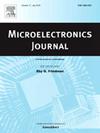The application of the optimized genetic algorithm in SerDes circuit design
IF 1.9
3区 工程技术
Q3 ENGINEERING, ELECTRICAL & ELECTRONIC
引用次数: 0
Abstract
In modern high-speed communication systems, the main function of Serializer/Deserializer (SerDes) is to convert parallel data into high-speed serial data streams at the sending end to reduce the number and complexity of transmission lines. This study aims to solve the complex design problem of replacing inefficient, traditional parallel structures with high-speed serial interface SerDes. The Genetic Algorithm (GA) is optimized by adding a selection and substitution procedure, and the optimized GA is applied to the common-source amplifier. The low-frequency gain, bandwidth, and slew rate target circuit optimization design are completed. Additionally, the Clock and Data Recovery (CDR) circuit in SerDes is analyzed and designed. The CDR structure based on phase selector/phase interpolator type is used as the CDR circuit of the high-speed serial interface, enabling the final circuit function and performance to meet the requirements. Simulation experiments denote that the optimized GA can ensure that the evolved parameters allow the transistor to work in the saturation region to complete the common-drain amplifier's circuit optimization design. After 250 generations of evolution, the maximum gain of 0.75 is roughly achieved at an input voltage of 1.2V and a Metal Oxide Semiconductor (MOS) transistor width of 20 μm. The energy consumption per bit of data in the circuit based on the optimized GA is 16.8 pJ, 19.6 % lower than the 20.1 pJ of the conventional circuit before optimization. Therefore, the multi-objective circuit optimization design with a moderate gain is realized.
求助全文
约1分钟内获得全文
求助全文
来源期刊

Microelectronics Journal
工程技术-工程:电子与电气
CiteScore
4.00
自引率
27.30%
发文量
222
审稿时长
43 days
期刊介绍:
Published since 1969, the Microelectronics Journal is an international forum for the dissemination of research and applications of microelectronic systems, circuits, and emerging technologies. Papers published in the Microelectronics Journal have undergone peer review to ensure originality, relevance, and timeliness. The journal thus provides a worldwide, regular, and comprehensive update on microelectronic circuits and systems.
The Microelectronics Journal invites papers describing significant research and applications in all of the areas listed below. Comprehensive review/survey papers covering recent developments will also be considered. The Microelectronics Journal covers circuits and systems. This topic includes but is not limited to: Analog, digital, mixed, and RF circuits and related design methodologies; Logic, architectural, and system level synthesis; Testing, design for testability, built-in self-test; Area, power, and thermal analysis and design; Mixed-domain simulation and design; Embedded systems; Non-von Neumann computing and related technologies and circuits; Design and test of high complexity systems integration; SoC, NoC, SIP, and NIP design and test; 3-D integration design and analysis; Emerging device technologies and circuits, such as FinFETs, SETs, spintronics, SFQ, MTJ, etc.
Application aspects such as signal and image processing including circuits for cryptography, sensors, and actuators including sensor networks, reliability and quality issues, and economic models are also welcome.
 求助内容:
求助内容: 应助结果提醒方式:
应助结果提醒方式:


